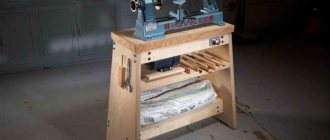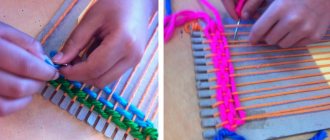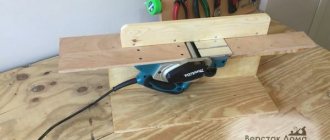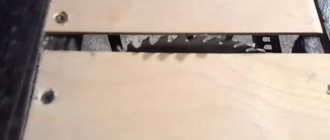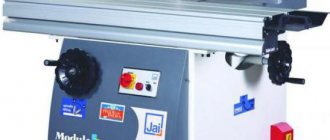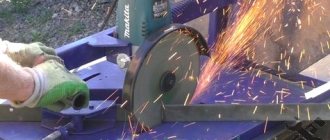Where a jigsaw fails, a jigsaw can always help out. For example, if you need to cut small figures from wood or plywood, or cut aluminum strip into small pieces.
Of course, it doesn’t make much sense to buy it for home use - it’s expensive. But doing it yourself is always welcome.
If you have a jigsaw, then all you need to do is make a stand for the jigsaw and a work table with a lever. You can also use an electric motor with a crank assembly as a drive.
In this article, we will share with you the best DIY jigsaw ideas on a budget. We advise you to read it.
DIY jigsaw from a sewing machine
From scrap materials found in your garage or purchased at a metal scrap yard, you can make many useful things and tools for your workshop.
For example, a grandmother’s sewing machine, inherited, can be used. This is a great option for some homemade projects.
Well, since this article is about machines, we will make a jigsaw, or rather, a tabletop jigsaw.
The idea was shared by the author Mr Novruz.
All you need from the sewing machine itself is a metal case and a factory crank assembly.
We won't need the remaining spare parts, but they can be saved for making some other homemade devices.
The main materials that will be required to make a jigsaw from a sewing machine:
- metal strip;
- profile pipe (or corner);
- sheet metal;
- bearings;
- round steel bar;
- electric motor;
- fasteners - bolts with nuts.
Step one: making the frame.
To make a frame, you can use various materials at hand - in principle, any scrap metal that is available is suitable for this.
In this case, to make a jigsaw bed from a sewing machine, the master uses pieces of a rectangular profile pipe and a metal strip. We assemble the frame. We fix all the elements by welding.
Next, you need to attach the electric motor and the sewing machine body to the bed. We connect them together using a belt.
Step two: making a jigsaw blade holder.
At the next stage, we will start making another important part - the holder for the file. It's very easy to make.
You will need round steel and bolts. Cut the workpiece to the required length. On one side we drill a hole in it, on the other we cut out a groove.
In the place where the groove is located, it is necessary to drill holes on the sides and cut threads into them. We screw in a couple of bolts that will secure the tail part of the file.
After this, you need to drill another hole in the center of the round timber, and also cut a thread in it. We screw a bolt into it, which will fix the holder itself on the sewing machine rod, which goes up and down.
Step three: making a desktop.
Ideally use sheet metal. But since this material is not the most popular in the household, and many craftsmen simply may not have it in stock, you can use something else - for example, laminated chipboard.
In this case, we will focus on sheet metal. Cut out the workpiece to the required size.
We make markings and drill two holes next to each other. We process it with a metal file to create a groove for the file. We attach the work table to the top of the jigsaw frame.
Step four: making a bearing block for the saw
To prevent the jigsaw blade from moving in different directions while cutting workpieces, it is necessary to make a bearing block.
Cut a piece of metal strip. We weld “ears” with holes to it, install a bolt with a bearing, and scald it. Then we weld two more bolts. We put bearings on them and secure them with nuts.
The bearing block consists of one thrust bearing and two pressure bearings (they are located on the sides of the file).
The bearing block will need to be secured to the end of an L-shaped stand welded from two sections of corrugated pipe. And we weld the stand itself to the desktop.
Step Five: Installing the Jigsaw
At the last stage, all that remains is to paint the assembled structure and install it on a workbench or other suitable place. To fasten the frame, the master uses bolts and nuts.
You can watch the video below for details on how to make a homemade jigsaw from a sewing machine.
Yeah!!! What I Did From The Old Sewing Machine 2020
Considering that the author used parts that he had on hand, the design turned out to be budget-friendly - an excellent economical option for a home workshop or garage.
Technical description and components
The schematic diagram of any jigsaw machine is the same for different models.
It must contain the following parts:
- file;
- drive with a power of about 150 W;
- rocker for tensioning the file;
- working surface with graduation;
- drilling block, etc.
Consumables are fixed on the working surface. In advanced models, there are special devices for rotating movements of the part; in them, the working surface can change the angle of inclination.
The size of the surface will depend on your production and creative plans: the larger the part you are going to cut, the larger your production table should be. Traditional sizes are usually around 30 – 40 cm.
There are a wide variety of types of files. They depend primarily on the consumables. The dimensions of the parts for cutting also matter. Conventional saws for working with wood have a length of about 35–40 cm. They are able to saw parts made of wood or plastic with a thickness of no more than 100 mm.
The files also change with different types of materials; this mainly concerns their width: from 2 to 10 mm. Files can differ in the type of their tails - with or without pins. They are fixed in a special device for tensioning and even sawing. For this purpose, they have springs of a spring type.
Another important part of the machine: the crank assembly. Its function is difficult to overestimate: it is it that transmits movement from the drive to the saw, turning rotational motion into translational motion.
Assembly drawing of a jigsaw machine.
Due to this, the file begins to oscillate at a high frequency, the speed of such oscillations is on average about 800 - 1000 revolutions per minute. It is important to remember the amplitude of vertical vibrations; it should not exceed 50 mm.
In advanced modern jigsaw models, the speed varies depending on the type of consumable. Most desktop models operate in two speed modes. Most often these are 600 and 1000 rpm.
Jigsaw machine from a washing machine engine
In a homemade design, the drive can be different - at the discretion of the master. Let's consider the option of using a standard motor from an automatic washing machine.
Let's get to work. First you need to make a jigsaw machine bed.
You can use different materials - whatever is available. In this case, the author welded a frame from a strip of metal and a profile pipe.
The design is very simple: you need to make legs from a profile pipe, and from a strip you need to make a frame and an upper frame for attaching the desktop. At the bottom, a bracket is welded from a strip of metal to which the crank mechanism will be attached.
The first version of the tabletop jigsaw used a factory mechanism from a sewing machine. In this case, we will make this unit with our own hands.
First you need to make an eccentric shaft. On a lathe we turn a shaft of the required shape from a steel round timber.
We put a bearing on one end of the shaft, after which it will be necessary to weld a piece of round steel offset from the center.
Cut a piece of round pipe that will serve as the body. We insert the shaft inside it and put the bearing on the other end.
A metal strip with a movable (hinge) element is attached to the eccentric. We weld another piece of strip to the body.
A guide for the moving element is welded to this plate.
The next step is to weld the homemade crank mechanism to the frame.
A holder for a jigsaw file must be welded to the movable element (rod), which moves up and down.
After this you will need to make a desktop. What material to use is at your discretion. Ideally, it is better to use sheet metal. But plywood or chipboard will also work.
You need to make a hole in the work table for the saw blade.
As in the previous case, it is necessary to make a bearing block. We weld it to the L-shaped post. But in this case, the stand is made not from a profile pipe, but from a strip of metal. And the stand itself is welded directly to the frame.
At the last stage, it is necessary to weld the support platform for the electric motor, and you can start painting.
A pulley is placed on the eccentric shaft. We install the engine from the washing machine and connect its shaft to the eccentric one using a belt drive (belt).
How to make a jigsaw machine with your own hands is shown in detail in the video below. The idea was shared by the author Mr Novruz.
Yeah!!! Practical Useful Homemade Inventions
For convenience, it is better to place the engine on/off button on the side of the frame, as close to the workplace as possible. In general, the design is very simple, and repeating it will not pose any problems.
How does an electric jigsaw work?
Although the device of a jigsaw is not particularly complicated, its mechanism has certain features that require familiarization. To understand how to make a jigsaw, you first need to understand what causes the saw blade to make reciprocating movements. For the clearest understanding of the principle of operation of the device, we will present the main components that make up the mechanism of the instrument and describe their interaction with each other.
The basis of any electric jigsaw is the following components: an electric motor, a gearbox and a rod with a saw blade clamp.
Secondary, but no less important elements include the start button, support roller, cooling fan and sole. As additional functionality, many models have a pendulum stroke, a dust collector, lighting and a laser guide. We will not touch upon the operating principle of the latter, and will move on to a description of the interaction of the main elements of the mechanism. The high-frequency movements of the jigsaw saw blade originate from an electric motor, started by pressing a button or directly from the network. Rotation is transmitted along the shaft to a special “gearbox” mechanism with an eccentric, which interacts with the rod, forming a reciprocating movement. The mount installed at the end of the rod holds the saw that makes the cut. To minimize the load on the rod with the gearbox, the rear edge of the saw blade rests against the support roller. In this way, all components of the device are involved to perform the main task of sawing all kinds of materials.
Universal jigsaw machine
The ability to install different saw blades - for example, standard ones from a manual jigsaw and thin ones (from a jigsaw machine) allows you to significantly expand the range of work performed.
We bring to your attention a universal homemade wood cutting machine, which is designed for cutting both straight and shaped cuts due to the fact that you can install different files.
Moreover, it is very simple to make it - without any drawings. You don't even need a welding machine. We will use boards and wooden blocks as the main material.
Step one: making a desktop.
From boards 20-25 mm thick we glue a shield measuring 40x60 cm (as an option, you can use a sheet of plywood). Then we saw off four wooden blocks of 30x30 mm, 30-35 cm long.
We screw the prepared wooden blocks to the shield. We reinforce the joint with gussets made of plywood or wood. As a result, we got a desktop with legs.
For greater rigidity, we make a strapping of wooden blocks in the lower part of the legs.
Step two: making the stand.
At the next stage, we saw off two wooden blocks and connect them at an angle of 90 degrees. We strengthen the junction with scarves.
As a result, we got an L-shaped stand that needs to be screwed to the desktop. Then we make markings and drill a hole in the table for the saw blade.
Step three: installing the jigsaw.
The jigsaw is mounted under the work support table. The sole of the tool is fixed with metal clamps with a bolted connection.
Step four: assembly of the entire structure.
So we have come to the final stage of work on assembling a homemade jigsaw machine from an electric jigsaw.
After installing the L-shaped stand and the jigsaw with the saw blade, it is necessary to make a mount with a block of bearings that will hold the saw in the desired position.
Please note: the mount must be removable and therefore must be able to be quickly secured using wing bolts.
For a thin saw blade for figured cutting, a mount of a slightly different design will be used - see photo below.
You can watch step-by-step instructions for making a jigsaw from an electric jigsaw with your own hands in the video below. The idea was shared by the author of Hobi Market.
Scroll Saw and Jigsaw Table in The One Machine
This homemade design has a lot of advantages.
Firstly, it is versatility and practicality. Secondly, ease of manufacture and assembly. Thirdly, there is no need to use welding and an electric motor. Fourthly, the jigsaw, which is used as a drive, can be removed at any time and used for other work.
Homemade machine
You can make a jigsaw yourself: technical literature and the Internet offer many diagrams and drawings of electric jigsaw machines.
Making such a device is not difficult, and you will get significant benefits from it. You will be able to independently produce the furniture you need and realize the most daring creative ideas for the interior.
An example of manufacturing a jigsaw machine.
A homemade jigsaw machine will help you professionally make smooth parts of the most bizarre shapes. First, you need to decide on the design that is most suitable for you.
Homemade jigsaw from a compressor from a refrigerator
The drive of this design will be an electric motor, but not from a washing machine, as in one of the options described above, but from a refrigerator compressor.
The idea of a homemade product belongs to the author of the YouTube channel khám phá và sáng tạo.
The first step is to remove the electric motor from the compressor housing. After this, we cut out a circle from a piece of thick rubber and attach the engine to it.
Plastic ties are used to secure the electric motor. You need to drill holes in the rubber itself.
The base is a disk cut from a sheet of metal. We weld steel corners to it, and then screw on a rubber “cushion” with a motor.
We weld three legs - rings made of a round steel pipe - to the bottom of the base, and put rubber plugs on them.
Then you need to make a stand. We cut two pieces of rectangular corrugated pipe, connect them at an angle of 90 degrees, and weld them to the base.
Another metal disk is welded on top of the rack - this will be the work table. We cut a groove for the file.
At the last stage, all that remains is to paint the machine. To do this, it is convenient to use spray paint in cans.
You can watch the step-by-step process of making a stationary jigsaw with your own hands in the author's video.
Chế cưa bàn mini từ block tủ lạnh
The design turned out to be compact and quite simple to manufacture. This is the best option for a small home workshop.
This homemade machine is perfect if you are making various crafts from wood.
How to improve the design?
Of course, a manual jigsaw is not perfect, but it can be modified and brought to perfection.
- A rocker is being made. This type of structure will be tensioned using springs on one side and secured to the file on the other.
- We fasten the file between two rollers. Their function is to be guides.
- We use a factory jigsaw as a drive. A file is pulled between it and the rocker.
Note!
Do-it-yourself compressor: TOP-130 photo reviews of finished compressors. Step-by-step instructions + diagrams and drawings
Do-it-yourself wind generator: TOP-170 photo reviews of finished devices. Detailed DIY instructions for beginners
Do-it-yourself spot welding - the best master class on making homemade spot welding with step-by-step photo diagrams of do-it-yourself work
Jigsaw machine for cutting metal
We bring to your attention another homemade budget design that every home craftsman can make.
The idea of this design belongs to the author George Kosilov.
The first step is to make a work table on which the workpieces will be cut.
A sheet of metal 5-6 mm thick is perfect for making a tabletop. Cut out a circle of the required diameter.
Next, we cut off three blanks from the corrugated pipe. We cut one side of each workpiece at an angle.
We weld the profile pipes to the bottom of the round tabletop, placing them at the same distance from each other. As a result, we got a table with supporting legs.
The next step is to make a U-shaped lever, at the end of which a bearing block and a rail from the presser foot will be attached.
A square profile is used to make the lever. However, it makes sense to make a reinforced lever welded from two sections of profile.
We cut out a hole in the work table for the file, and also drill a few more mounting holes for attaching the jigsaw. You also need to drill holes in the base of the jigsaw.
We install the jigsaw under the tabletop. There we also attach the speed controller, placed in a homemade metal case.
We weld steel round timbers (“thrust bearings”) to the base of the support legs for better stability. It would be a good idea to glue some more rubber on them so that the machine does not slide on the table during operation.
The on/off button is installed in one of the legs.
Details on how to make a convenient and compact desktop machine from a jigsaw with your own hands are shown in the video. The design turned out just right - take note.
JIG SAW MACHINE Cutting metal is a pleasure
Choosing a jigsaw manufacturer
Most often, Russian consumers choose jigsaw machines from Proxxon, Dewalt, Hegner, Xendoll, Zubr, JET, Enkor Corvette and Croton. Each of them has its own advantages and disadvantages. Based on reliability and compliance with the characteristics declared by the manufacturer, we would single out machines from the German company Hegner. And their line of this equipment is longer than many others, but be sure to insist on sea trials when purchasing, regardless of which company’s machine you are planning to buy.
And even if it is possible to choose from 2 identical machines, demand that both are turned on. Buy one that has less operating noise and vibration.


